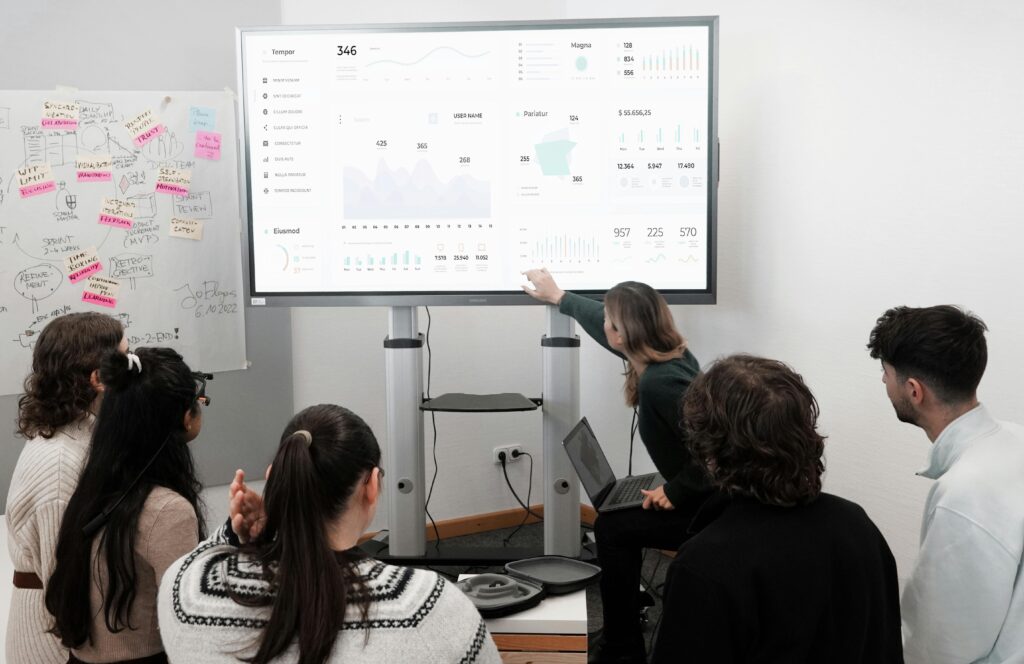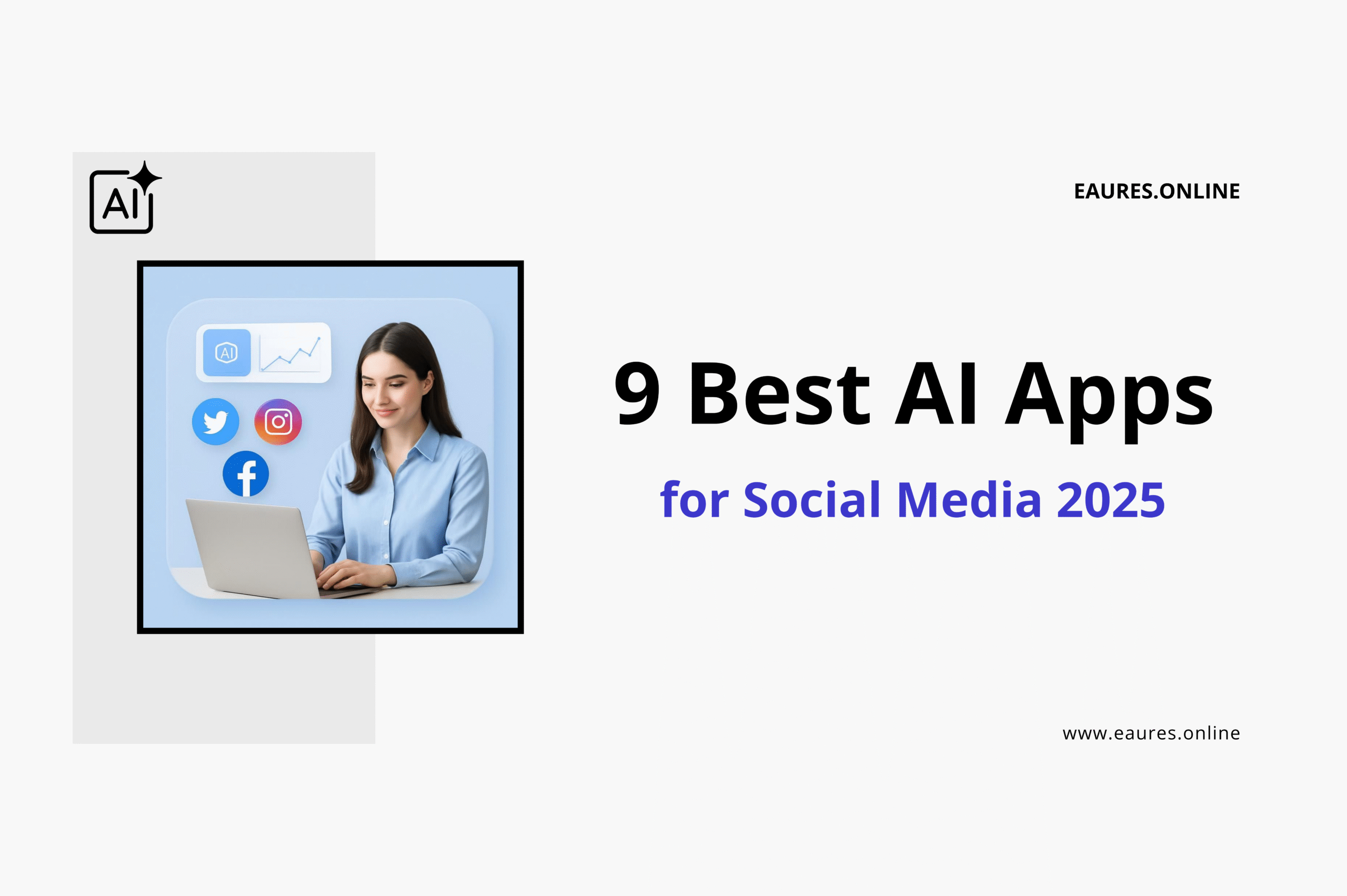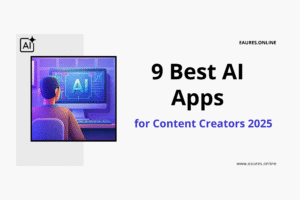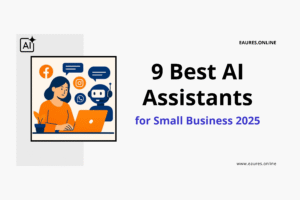Table of Contents
9 Best AI Apps for Social Media 2025
Why These Are the Best AI Apps for Social Media in 2025
If you’re scaling social channels this year, your toolkit should combine writing, video, design, scheduling, and analytics—without turning your day into tab-hopping chaos. The Best AI Apps for Social Media in 2025 align on three non-negotiables: (1) reliably on-brand content, (2) fast iteration across formats (posts, carousels, short-form video), and (3) measurable lift in reach and ROI. In this guide, we highlight nine platforms that meet those standards, and we show you how to stack them into workflows you’ll actually use.
To give you both breadth and depth, you’ll find quick “best for” snapshots, core features, pricing context, and power-user tips. Throughout, we reference respected roundups like the Zapier breakdown of AI social media tools for practical comparisons embedded inside sentences, such as the way the best AI social media management picks are organized by use case in the Zapier blog’s review for speed reading and shortlisting.
Top Picks at a Glance (Use Cases & Strengths)
Before we dive deep, here’s the strategic overview—how each app earns a place among the Best AI Apps for Social Media in 2025:
- Buffer — Best for creators and small teams that want AI writing, scheduling, and simple analytics in one gentle learning curve.
- Hootsuite (OwlyWriter + Reels tools) — Best for multi-brand management, dashboards, listening, and faster ideation from prompts.
- Sprout Social (AI Assist) — Best for larger teams needing governance, listening, case routing, and AI-assisted response at scale.
- Canva (Magic Design & Magic Write) — Best one-stop for thumbnails, carousels, story templates, and quick brand kits.
- CapCut — Best for TikTok/Shorts/Reels editing with templates, captions, jump-cut cleanup, and AI-powered effects.
- OpusClip — Best for auto-clipping long videos into high-retention shorts with highlights, B-roll suggestions, and hooks.
- Flick — Best for hashtag strategy, caption ideation, and post timing suggestions tailored to your audience.
- Jasper — Best for brand-safe copy at scale, style guides, and campaign templates across platforms.
- Synthesia — Best for instant presenter videos (avatars) to explain features, announce updates, or localize content.
We’ll cover each one with practical guidance on when to use it and how to fit it into a single streamlined stack of the Best AI Apps for Social Media.

1) Buffer — A Friendly, Unified Starting Point
Best for: Solo creators and lean teams who need a reliable planner with AI captions and light analytics.
Why it’s one of the Best AI Apps for Social Media: Buffer blends post ideation, assisted writing, and scheduling with just enough analytics to learn what works. You can keep a high cadence without over-engineering your stack.
Stand-out AI features
- Caption drafting, tone adjustments, and rephrasing for multi-network distribution.
- Queue optimization with ideas derived from your past top performers.
Ideal workflows
- Draft a week of posts using AI prompts, then adjust to your brand voice.
- Repurpose one update across networks with channel-specific tweaks (hashtags, length).
Limitations to note
- Analytics and listening are lighter than enterprise dashboards (see Hootsuite/Sprout).
Pro tip
- Build your caption “golden snippets” so the AI can remix high-performing hooks and CTAs that have already worked for you.
2) Hootsuite (OwlyWriter & Reels Tools) — Multi-Brand Mastery
Best for: Agencies and brand managers running several accounts with approvals, listening, and reporting.
Why it’s one of the Best AI Apps for Social Media: Hootsuite’s OwlyWriter suggests captions, repurposes blog posts, and helps ideate content pillars—then slots neatly into your approval flows and dashboards.
Stand-out AI features
- Topic-to-post ideation for multi-week calendars.
- AI repurposing (e.g., event recap → carousel captions + Reel ideas).
- Listening and competitive insights inside the same dashboard.
Ideal workflows
- Load campaign themes quarterly, then use AI to spin daily variations.
- Route replies via smart inbox and templates for faster, consistent community management.
Limitations to note
- Overkill for single brands or small side projects.
Pro tip
- Use saved replies and AI drafts to maintain individual voice per client while ensuring response SLAs.
3) Sprout Social (AI Assist) — Governance, Listening & Scale
Best for: Mid-to-enterprise teams prioritizing governance, social care, and executive-level reporting.
Why it’s one of the Best AI Apps for Social Media: Sprout’s AI Assist helps with suggested replies, sentiment context, and escalation routing, reducing handle-time for support and community teams while surfacing trends.
Stand-out AI features
- Smart routing and collaborative case handling.
- Draft responses that match brand tone guidelines.
Ideal workflows
- Use listening to detect conversation spikes, then spin AI-assisted posts and executive summaries.
- Connect to your CRM for closed-loop insight (which social threads lead to revenue or tickets).
Limitations to note
- Pricing and complexity are designed for larger teams; not a minimalist tool.
Pro tip
- Build an internal “tone playbook”—AI Assist will be far more accurate and less likely to produce generic replies.
4) Canva (Magic Design & Magic Write) — Design at the Speed of Social
Best for: Non-designers who still want on-brand carousels, thumbnails, and story sets.
Why it’s one of the Best AI Apps for Social Media: Canva’s Magic Design and Magic Write keep brand kits intact while making it trivial to produce visual variations for A/B tests—critical when you need to iterate thumbnails or carousel covers.
Stand-out AI features
- One-prompt draft designs for post types (Reel covers, LinkedIn carousels, Pinterest pins).
- Magic Write for captions and descriptions directly in the canvas.
Ideal workflows
- Start with your brand kit, generate three design variants, then test and refine copy with Magic Write.
- Export brand-consistent templates your team can use repeatedly.
Limitations to note
- Heavy video editing is better handled by CapCut/OpusClip.
Pro tip
- Maintain a “Results Library” of top-performing layouts so Magic Design leans toward your proven styles.
For a practical overview of AI design and posting tools, the Piktochart blog’s guide to AI tools for social media content creation explains how marketers mix design and scheduling in daily workflows.

5) CapCut — Rapid Short-Form Video Production
Best for: TikTok, Reels, and YouTube Shorts editors who need speed with captions, effects, and cuts.
Why it’s one of the Best AI Apps for Social Media: CapCut pairs templates with smart editing to kill busywork—auto-captions, silence removal, beat-matched cuts, and easy resizing for multiple platforms.
Stand-out AI features
- Auto-subtitles and cuts for talking-head content.
- Smart background removal and quick B-roll placement.
Ideal workflows
- Record a 90-second talking head, let CapCut produce three platform-specific cuts with captions, then A/B test hooks on TikTok and Reels.
Limitations to note
- Not ideal for strict corporate governance or complex multi-brand approvals.
Pro tip
- Create a “Hook Bank” overlay pack (3–5 second openers). Use the same assets across videos to build brand recognition.
6) OpusClip — From Long Videos to High-Retention Clips
Best for: Podcasters, webinar hosts, and B2B teams turning long-form into a month of shorts.
Why it’s one of the Best AI Apps for Social Media: OpusClip automatically finds moments with high “viral potential,” adds captions, and suggests titles, so you can ship more clips with less creative fatigue.
Stand-out AI features
- Highlight detection and automatic cut selection.
- AI titles, dynamic captions, and suggested hooks.
Ideal workflows
- Upload a webinar; export 8–15 shorts keyed to chapter topics and trending hooks.
Limitations to note
- You’ll still want manual passes for brand nuances and compliance.
Pro tip
- Feed timestamps for “gold moments” from your show notes; AI gets even better when you hint where to look.
7) Flick — Hashtags, Captions & Timing Intelligence
Best for: Instagram and TikTok growth where hashtags and timing influence early momentum.
Why it’s one of the Best AI Apps for Social Media: Flick’s hashtag research and AI captions minimize guesswork. It helps diversify tag sets, avoid banned or overly competitive tags, and nudge posts toward discoverability.
Stand-out AI features
- Smart hashtag groups by topic difficulty.
- Caption inspiration aligned with audience interests and tone.
Ideal workflows
- Build rotating hashtag sets (easy/medium/hard) and test which blend nets the best reach for each content pillar.
Limitations to note
- Works best when paired with a scheduler (Buffer/Hootsuite) and a design tool (Canva).
Pro tip
- Create separate hashtag collections per intent (educate, entertain, promote) to avoid repetition while staying on theme.
For more benchmarking insights, AIOSEO’s roundup of AI social media post generators compares prompt styles and output quality, useful when you’re evaluating both captioning and ideation.
8) Jasper — Brand-Safe Copy, Campaigns & Style Guides
Best for: Teams that need repeatable, on-brand copy across platforms, ads, and landing pages.
Why it’s one of the Best AI Apps for Social Media: Jasper shines when you need consistent voice. Its brand voice features, templates, and campaign workflows make it easier to keep multi-channel messaging aligned.
Stand-out AI features
- Brand voice profiles and knowledge ingestion.
- Campaign templates (post + ad + landing copy) from one brief.
Ideal workflows
- Start with a single creative brief; generate an entire week’s posts plus accompanying ad variants.
Limitations to note
- You’ll want a complementary scheduler and design tool for end-to-end execution.
Pro tip
- Train Jasper on your top 20 “brand-defining” posts and emails; then use it to remix proven angles for new campaigns.
To see how AI copy pipelines extend beyond social, explore this guide to the Best AI Apps for Content Creators in 2025, which shows how creators align writing, design, and video into cohesive production flows on a weekly cadence.
9) Synthesia — Human-Style Presenter Videos (at Scale)
Best for: Product explainers, update announcements, and localized content with on-screen avatars.
Why it’s one of the Best AI Apps for Social Media: Synthesia generates presenter-led videos without a camera crew—ideal for multilingual social posts, feature walkthroughs, and bite-size tutorials where human presence boosts trust.
Stand-out AI features
- Avatars that deliver your script in many languages.
- Templates for product updates, FAQs, and training bites.
Ideal workflows
- Turn a product update blog into three 30-second avatar videos tailored for LinkedIn, X, and YouTube.
Limitations to note
- Avatars look professional but not fully “live-action”—mix with B-roll and product shots for realism.
Pro tip
- Use on-screen captions and large text callouts so message clarity doesn’t depend on lip-sync alone.
For deeper ideas, see Synthesia’s post on AI tools, which rounds up complementary apps for script writing, editing, and distribution that pair nicely with avatar video. If you prefer a visual explainer, a helpful YouTube breakdown on AI content workflows shows step-by-step clipping, captioning, and posting patterns you can replicate.

How to Choose the Best AI Apps for Social Media (Decision Framework)
Pick tools that shorten your path from concept to publish to insight. Use this checklist to score contenders among the Best AI Apps for Social Media:
- Fit to your format mix
Do you ship mostly carousels and captions (lean on Canva + Buffer + Jasper), or is your flywheel video-first (CapCut/OpusClip + Hootsuite)? - Brand safety & governance
If approvals, roles, and audits matter, shortlist Hootsuite or Sprout Social and attach Jasper for consistent voice. - Speed to first draft
Your AI should turn briefs into multi-asset drafts in minutes. If it doesn’t, it isn’t saving real time. - Distribution depth
Ensure your scheduler supports all your priority networks, formats, and analytics (e.g., LinkedIn carousels, Instagram Reels, YouTube Shorts). - Learning loop
You need easy analytics that map to decisions (post timing, topic clusters, hook styles). If insights don’t change behavior, they’re trivia. - Extensibility
Consider how the tool integrates with your content calendar, DAM, CRM, or help desk. The best Best AI Apps for Social Media become hubs—not silos.
For a broader productivity lens beyond social, this overview of the Best AI Tools for Productivity in 2025 shows how teams connect meeting notes, briefs, and post-production into a single automated pipeline.
Proven Stacks You Can Copy (2025)
A) Creator Stack (Solo or Duo)
- Canva for templates → CapCut for shorts → Buffer for schedule/analytics → Flick for hashtags.
- Add Jasper when you want a repeatable voice for newsletters and landing pages.
Why it works: Visuals and video stay fast; captions stay on-brand; you learn timing and hashtag blends without overwhelm.
B) SMB Stack (In-House Marketing)
- Jasper for campaign briefs → Canva for carousels → Hootsuite for approvals, scheduling, and reporting → OpusClip for repurposing webinars.
Why it works: One brief yields many assets; managers approve in one place; you recycle events and long-form into weekly short-form content.
C) Agency Stack (Multi-Client)
- Hootsuite for multi-brand governance → Jasper for brand voice per client → CapCut/OpusClip for clients with video → Flick for IG growth.
Why it works: Clear roles and approvals; bespoke voice per client; rapid short-form production; repeatable hashtag strategy.
For cross-department automation and assistant workflows that extend beyond social posting, compare ideas in the 9 best AI assistants for small business in 2025, which covers how owners pair scheduling and CRM automations with creative output.
Editorial Playbooks that Multiply Results
1) The Pillar → Cluster → Clip Model
- Draft a monthly pillar (e.g., “2025 buyer’s guide”).
- From that, produce 6–8 cluster posts and 10–15 short clips.
- Use OpusClip to extract moments; Canva for carousel recaps; Buffer or Hootsuite to schedule clusters alongside clips.
2) Hook & Format A/B
- Keep a Hook Bank (question, contrarian, stat, story).
- Test each hook across two formats (carousel vs. short).
- CapCut + Canva for variants; track outcomes in your scheduler’s analytics.
3) Authority Through Explainers
- Use Synthesia to create short avatar explainers in multiple languages.
- Pair with Jasper to maintain consistent terminology across posts, captions, and subtitles.
If you’re running paid social alongside organic, you’ll move faster by repurposing creative for performance channels; this comparison of AI video makers for ads shows how to go from concept to ad-ready variations that align with platform best practices.
Advanced Tips to Unlock Each Tool
- Buffer: Tag posts by content pillar (educational, inspirational, promotional). Your analytics will reveal which pillar deserves more real estate.
- Hootsuite: Build streams that watch competitor launches and industry phrases; prompt OwlyWriter to write “counterpoints” or “fast takes” when a trend spikes.
- Sprout Social: Use automated rules to separate presales questions from support issues; feed resolved conversations into a knowledge base for Jasper to ingest.
- Canva: Batch-create three thumbnail variants for every video; often the thumbnail is the single biggest lever on CTR.
- CapCut: Use AI captions even when you’ll manually edit—captions give viewers a path when they scroll with sound off.
- OpusClip: Add a 3-second branded opener and a consistent end screen; teach the AI to place them automatically for brand cohesion.
- Flick: Rotate hashtag sets weekly; mixing difficulty tiers prevents plateauing reach.
- Jasper: Save polished prompts as templates (e.g., “Twitter product launch thread” or “LinkedIn pain-point story”).
- Synthesia: Keep scripts to ~90–120 words per post. Shorter scripts feel more natural with avatars and boost watch completion.
For complementary perspectives on choosing and combining tools, the AIOSEO review of social media post generators and Zapier’s best AI social media management roundup are solid, up-to-date resources that you can read while evaluating your stack.

Common Mistakes to Avoid in 2025
- One-size-fits-all captions
Even the Best AI Apps for Social Media can’t compensate for identical copy pasted across platforms. Nudge tone, length, and CTAs per channel. - Ignoring retention in video
Hook, pacing, captions, and framing matter more than polish. Use CapCut or OpusClip to front-load value. - No learning loop
Without post-mortems, AI only saves time—it doesn’t grow results. Use analytics to retire weak hooks, promote winning angles, and evolve your Hook Bank. - Skipping brand guardrails
Define “never say” lists, claims substantiation rules, and tone do’s/don’ts—then feed them into Jasper, Hootsuite, or Sprout. - Over-automating replies
AI can draft responses; humans should approve sensitive interactions. Blend speed with empathy.
To see how broader creator pipelines tie together, this breakdown of the Best AI Apps for Content Creators in 2025 details how writing, design, and editing combine to push more polished content without sacrificing authenticity.
FAQs: Best AI Apps for Social Media (2025)
What makes an app one of the Best AI Apps for Social Media?
It should shorten ideation, preserve your brand voice, respect approvals, and translate insights into action. If it doesn’t help you publish faster and smarter, keep looking.
Which single tool should I start with?
For creators: Buffer or Canva. For multi-brand teams: Hootsuite. For support-heavy orgs: Sprout Social. Add Jasper when voice consistency matters.
How do I combine these tools without overlap?
Pick one scheduler (Buffer/Hootsuite/Sprout), one design tool (Canva), one video tool (CapCut/OpusClip), one writing brain (Jasper), one discoverability booster (Flick), and optional avatar video (Synthesia).
Will AI replace my social media manager?
No. The manager’s value is strategy, empathy, and taste. The Best AI Apps for Social Media just make those skills scale.
Conclusion: Build Your 2025 Stack with Intent
The Best AI Apps for Social Media in 2025 don’t chase novelty; they reduce friction from idea to post to learning. Start small: choose one scheduler, one writing tool, one design/video pair, and one analytics source of truth. As results compound, layer in advanced pieces—hashtag intelligence, avatar videos, and governance. Keep your Hook Bank fresh, your brand rules explicit, and your cadence sustainable. That’s how you win this year.
For more cross-functional planning beyond social, review the Best AI Tools for Productivity in 2025 to align content calendars, meetings, and briefs with the same automation mindset that powers your social growth.
Embedded Internal & External Links Used (Contextual, Inline)
- Internal:
- Compared assistant workflows inside the 9 best AI assistants for small business in 2025: https://www.eaures.online/9-best-ai-assistants-for-small-business-2025
- Productivity stack synergies in Best AI Tools for Productivity in 2025: https://www.eaures.online/best-ai-tools-for-productivity-2025
- Ad creative repurposing via AI video makers for ads: https://www.eaures.online/5-best-ai-video-makers-for-ads-2025
- Creator pipeline overview in Best AI Apps for Content Creators in 2025: https://www.eaures.online/best-ai-apps-for-content-creators-2025
- External:
- Practical comparisons in the Zapier blog’s best AI social media management roundup: https://zapier.com/blog/best-ai-social-media-management/
- Caption/tool comparisons in AIOSEO’s AI social media post generators: https://aioseo.com/best-ai-social-media-post-generators/
- Design + posting insights in Piktochart’s AI tools guide: https://piktochart.com/blog/ai-tools-social-media-content-creation/
- Tool ideas around avatar video in Synthesia’s AI tools post: https://www.synthesia.io/post/ai-tools
- Walkthrough example on YouTube for AI content workflows: https://www.youtube.com/watch?v=aKwl25fDeHo




